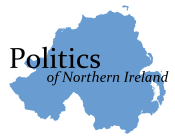- Northern Ireland Assembly (1982)
-
Northern Ireland 1973–98 
This article is part of the series:
Politics and government of
Northern IrelandInterim bodies Northern Ireland Assembly (1973)
Northern Ireland Executive (1974)
Constitutional Convention (1975)
Northern Ireland Assembly (1982)
Northern Ireland Forum (1996)Elections 1973 · 1975 · 1982 · 1996 Members 1973 · 1975 · 1982 · 1996 See also Anglo-Irish Agreement
New Ireland Forum
Northern Ireland by-elections, 1986
Northern Ireland sovereignty referendum, 1973
The Northern Ireland Assembly established in 1982 represented an ultimately unsuccessful attempt to restore the devolution to Northern Ireland which had been suspended 10 years previously. The Assembly was abolished in 1986.
Contents
Origins
The Assembly emerged as a result of initiatives by the then Secretaries of State for Northern Ireland, Humphrey Atkins and James Prior. The first step in this process was a white paper called The Government of Northern Ireland: A Working Paper for a Conference, published on 20 November 1979. This established a conference, attended the following year by the Democratic Unionist Party, the Alliance Party and the Social Democratic and Labour Party (SDLP). (The UUP refused to become involved in protest at a decision to allow discussions on an Irish dimension, discussions which the DUP also boycotted.) Talks between the DUP, Alliance and SDLP took place between 7 January and 24 March 1980, but failed to reach agreement.
In July 1980, the British Government published a discussion document, "The Government of Northern Ireland: Proposals for Further Discussion"[1] which suggested creating a devolved Assembly either with compulsory power sharing or Majority Rule. The power sharing option proved unacceptable to Unionists while Nationalists and the Alliance Party were reluctant to return to the Majority Rule model. Consequently on 27 November 1980 Humphrey Atkins, reported to the House of Commons that there little prospect for a devolved government in Northern Ireland due to a lack of consensus amongst the parties.
With 1981 dominated by the Hunger Strikes and the Prisons issue, constitutional initiatives took a back seat to the security situation. However on 5 April 1982, Atkin's successor James Prior published a white paper "Northern Ireland: A Framework for Devolution"[2] which proposed what was referred to as partial or rolling devolution. Under the proposals a 78 member assembly would be elected by proportional representation using the Single Transferable vote as in 1973. The Assembly's role at first would only be to scrutinise Government Departments as the white paper stated its role would be "consultative and deliberative, including scrutiny of draft legislation and making reports and recommendations to the Secretary of State which he will lay before Parliament." An executive would be formed consisting of not more than 13 members.
However powers could be gradually devolved to the Assembly if 70 per cent of Assembly members agreed. These powers would be transferred back to the Secretary of State if that consent was later withdrawn. Furthermore some powers functions such as Law and Order would remain with the Secretary of State, even if full devolution was achieved. Cross border issues would remain the prerogative of the Westminster Parliament.
Election
Main article: Northern Ireland Assembly election, 1982The electoral system proved to be hugely controversial. While there was general acceptance that the elections should take part using the Single Transferable Vote system, the decision to use the same 12 constituency boundaries used in 1973 rather than the new 17 constituency boundaries which were later adopted in 1983 was heavily criticised.
Great interest centred on the performance of Sinn Féin, fighting its first full election in many decades and on the inter-Unionist rivalry between the DUP and the UUP. The former had pulled ahead in the European election of 1979 and the Local Council Elections of 1981 but had suffered a setback in the 1982 by-election which followed the murder of Robert Bradford.
The results were seen as a positive step for the new electoral strategy of Sinn Féin which gained 5 seats and narrowly missed winning seats in Belfast North and Fermanagh and South Tyrone. The SDLP were disappointed with their 14 seats and one of these was subsequently lost in a by-election to the UUP as Seamus Mallon was disqualified following a successful UUP election petition on the grounds that he was ineligible as he was a member of Seanad Éireann at the time. On the Unionist side the UUP gained a clear lead over the DUP, while the UUUP failed to make an impact and, as a result, folded two years later. In the centre Alliance consolidated with 10 seats including unexpected wins in North and West Belfast. The Workers Party failed to make a breakthrough despite respectable vote shares in places like North and West Belfast.
Aftermath
The boycott by the Nationalist parties meant that the planned devolution never took place, while the UUP also intermittedly boycotted proceedings. Following the Anglo-Irish Agreement of November 1985, Unionists insisted on using the debating chamber to protest at the Agreement, resulting in an Alliance walk-out on 5 December 1985[3]and subsequent boycott. As a result, the government abolished the Assembly in 1986 and it would be over a decade before a new Assembly was restored to Northern Ireland
Speaker of the Northern Ireland Assembly
- 1982–1986 James Kilfedder (Ulster Popular Unionist Party)
References
Elections and referendums in Northern Ireland Elections Local government elections 1973 · 1977 · 1981 · 1985 · 1989 · 1993 · 1997 · 2001 · 2005 · 2011Referendums Categories:- Government of Northern Ireland
- 1982 establishments in Northern Ireland
- 1986 disestablishments
- Politics of Northern Ireland
Wikimedia Foundation. 2010.
